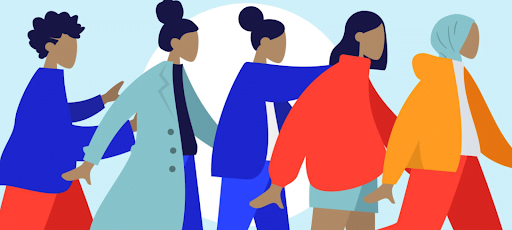When it comes to using any kind of images in your work, it can be difficult to avoid those stereotypical library images that tend to include rows of bookshelves or glasses. On their own, these things are pretty great, but it certainly doesn’t accurately reflect the diverse work of libraries.
Unfortunately, these out-dated ideas around libraries are hard to shift. This article in the New York Times discusses a particularly pervasive image of an archetypal library, shared widely online, which was actually built in the garage of the late Richard Macksey’s home in Baltimore. And this study from Digital Commons University of Nebraska looks into the online proliferation of librarian stereotypes in stock photography and memes.
When representing our users the same clichés come up time and again, so in this post we’ll suggest where you can find good sources of images that don’t limit you to low-res, boring stereotypes.
When choosing images, do consider the technical aspects and, where possible, opt for the svg file format as they can be resized without losing quality. It’s also important to pay attention to the licence of the images you use, so we’ve included notes about this where available.
Icons
When choosing icons you’ll want them to reflect more than just a small section of your users. This insightful article from UX Collective considers the complexities of designing avatars that are not reflecting our own unconscious biases.
A great example of work to widen representation of women in icons and avatars is Noun Project’s 2019 Iconathon design workshop. The end result is over 60 icons in the Redefining Women icon collection that challenge the way women are usually depicted in professional capacities. The icons are free and available under creative commons licence. You can read about the project on the Noun Project blog.
For many of our web projects, we need reliable, good quality line icons. These are important for buttons, menus and other UI elements:
For a range of emojis and other icons, Iconduck provides open source, openly licensed iconsets. Ikonate and Iconoir are solid vector line icons available under an MIT licence.
And for something more colourful, there’s OpenMoji. They have some useful ‘skin tone’ options for gestures and other available emojis.
If you need user icons, there’s the not-at-all-boring boringavatars.com.
And sure, it’s a niche use case, but bioicons may just be the open-source life science icons you didn’t know you needed.
Illustrations
Images can be helpful for increasing engagement with blog posts, user guides as well as social media posts. Images and illustrations can work to break up large sections of text, and can also be particularly useful for adding visual information to help guides.
Beyond the Pixabay and Pexels collections of stock photos, there are some impressive new illustration collections emerging. These collections are often shared under open licences and allow you to modify graphics to create your own versions:
Opendoodles is a set of free illustrations that offer choices of colour theme and can also be edited in blush.design any way you want.
Undraw.co is another set of high-quality illustrations, created by Katerina Limpitsouni and available under open source licence.
And an impressive new addition that we’ve only recently discovered is IRA Design. This is a tool that lets you use a collection of gradients and hand drawn sketch components to create your own illustrations.
For more lovely illustrations of people in a different style, try humaaans.com. humaaans allows you to edit and change colours as well as swapping out trousers, tops and hairstyles to build your own custom characters. Open Peeps is another collection of diverse open source hand-drawn illustrations, or try manypixels for a wide range of useful and editable open source illustrations.

We think this article from the UX team at Shopify, You can’t just draw purple people and call it diversity, really illuminates the challenges of un-stereotyping images and icons, and this statement gets to the heart of the matter:
“If you want to be inclusive, you need to illustrate different people, not different attributes. Instead of trying to imagine the average person, and then plug in the various attributes—which, uh, inevitably somehow start to look like us—we set out to illustrate every person. Or, rather, any person, so long as they were specific and complete.“
Meg Robichaud – Shopify UX
So, with that in mind, there’s hope that we’ll see an end to boring stereotypes and that this new generation of images, icons and illustrations will lead to content that reflects both the services as well as users of libraries today.
GET IN TOUCH
